How to illuminate your garden
A good garden is always a source of inspiration. Light and darkness are elements that complement the design and provide a cozy touch, generating different atmospheres according to the time of day.
During the night, one of the best ways to highlight details of your garden is through the use of low voltage outdoor lights, both for safety and for economy.
This type of light sources offer the advantage of being resistant and safe to electric shocks, so that children and pets will be safe, and there are some models that can be powered by solar energy accumulated during the day.
The use of different types of lighting generates a variety of atmospheres in your garden.
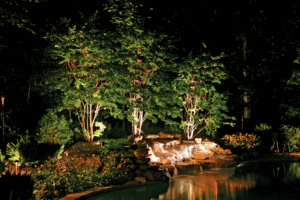
Photography: www.clarkslandscape.com
MATERIALS
- Transformer. It decreases the voltage of an electric circuit of alternating current.
- Low voltage cable. It transmits electricity.
- Timer. Used to automate the on and off.
- Low voltage lamps. As sources of light
Low lighting: ideal for garden routes, steps or corridors.
TIPS
To achieve having different atmospheres you can use the backlight technique, that is, to use a point of light located behind the objects, that does not go directly to the spectators, and that generates a contrast of lights and shadows.
Shadows are as important as light, so it is important to place light sources at a good distance and at a certain height.
The different activities that will be carried out in the garden should be taken into account, such as: reading a book, meals abroad, a soccer game; since each work requires a special type of lighting as well as degree of intensity. Avoid reflections and glare by properly positioning the lamps.
In the case of underwater lighting, it is recommended to use it only if you are going to take care that the water is always clean.
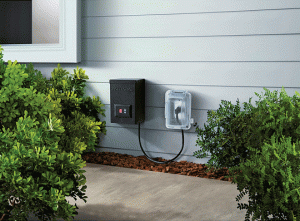
Photography: www.lowes.com
GET DOWN TO WORK!
Install a transformer that is resistant to water and outdoor conditions. Follow the instructions of the installation manual provided by the manufacturer. Do not use extension cords.
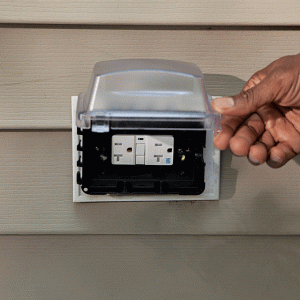
Photography: www.lowes.com
The transformer is connected to a standard outlet, reducing the house current (120 volts) to a 12 volt AC current, it is recommended to install an automatic timer so that the garden lights turns on and off at the desired time.
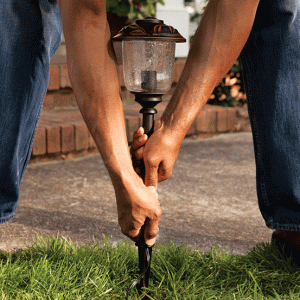
Fotografia: www.lowes.com
Install the first lamp at a minimum of 10 feet from the transformer. Connect the lamps using connectors. It is recommended to bury the wiring to hide it from view and avoid accidents.
TYPES OF LIGHTING
The height of the light sources can be low in garden routes, steps or corridors, while a medium height is recommended in focal points in order to highlight some element such as bushes or fountains.
High height lighting is used to illuminate tall trees, while background lighting is recommended for the desired architectural elements.
Finally, there is also underwater lighting for pools and ponds.
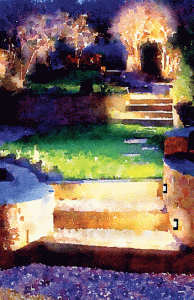
Illustration: Carlos Escalante
Low lighting: ideal for garden routes, steps or corridors.
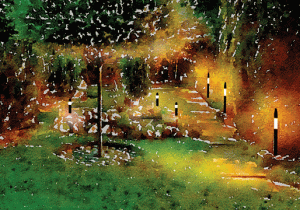
Illustration: Carlos Escalante
Medium height lighting, for focal points like bushes or fountains.
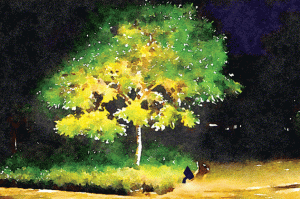
Illustration: Carlos Escalante
High lighting, used to illuminate tall trees.
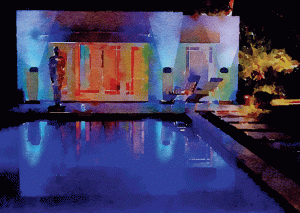
Illustration: Carlos Escalante
Background lighting, highlights desired architectural elements.
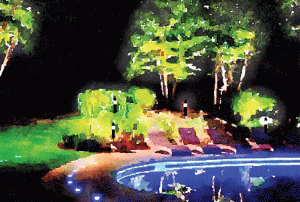
Illustration: Carlos Escalante
Underwater lighting for pools and ponds.
TYPES OF OUTDOOR LAMPS
There are lamps made with different materials, such as those made of cast metal that are durable and generally have a lifetime guarantee, while those of aluminum have the advantage of being stainless; and finally the plastic ones are economical and resistant to different climates, besides being easy to install. According to the type of lighting we can classify them into five categories:









